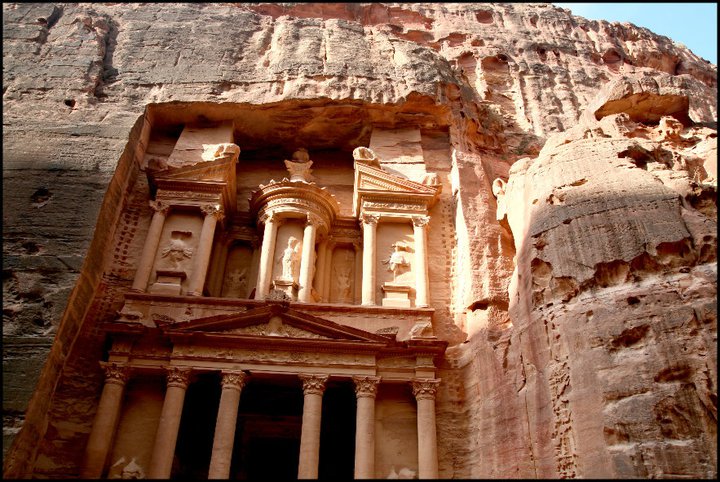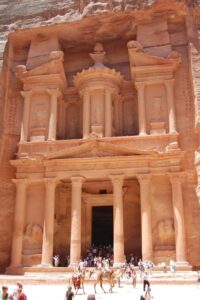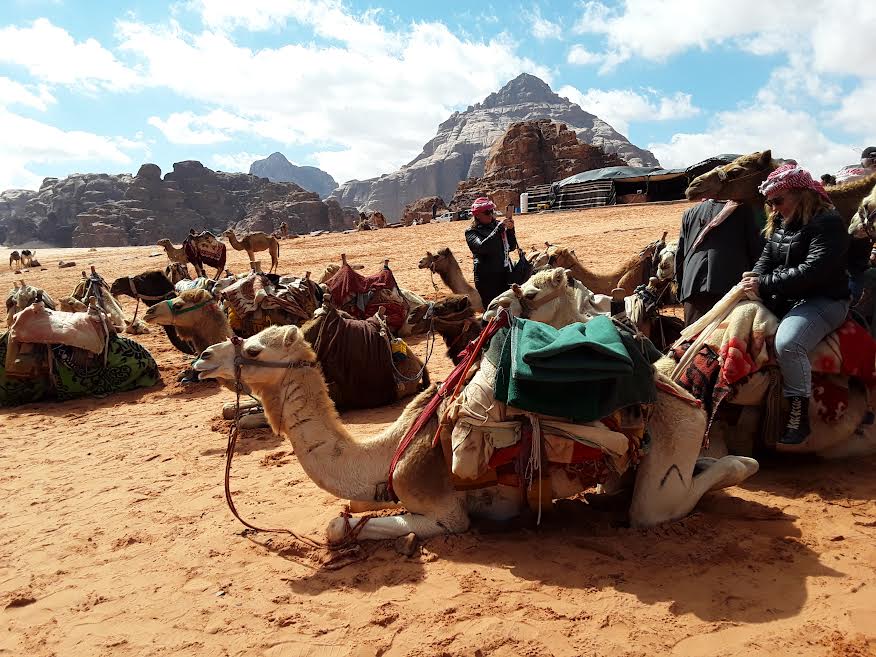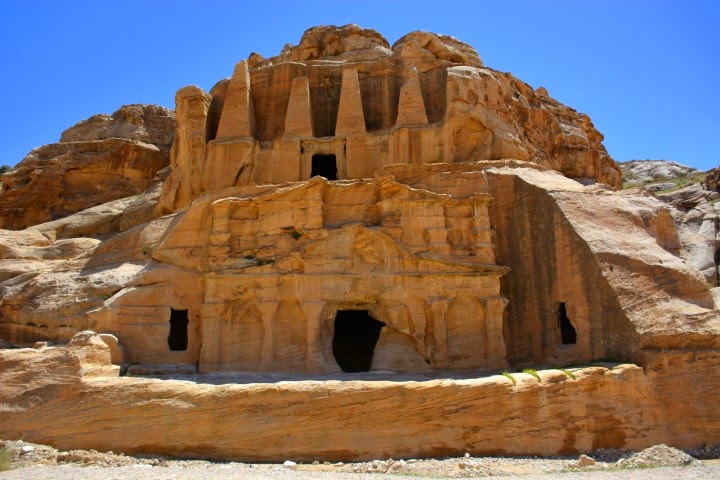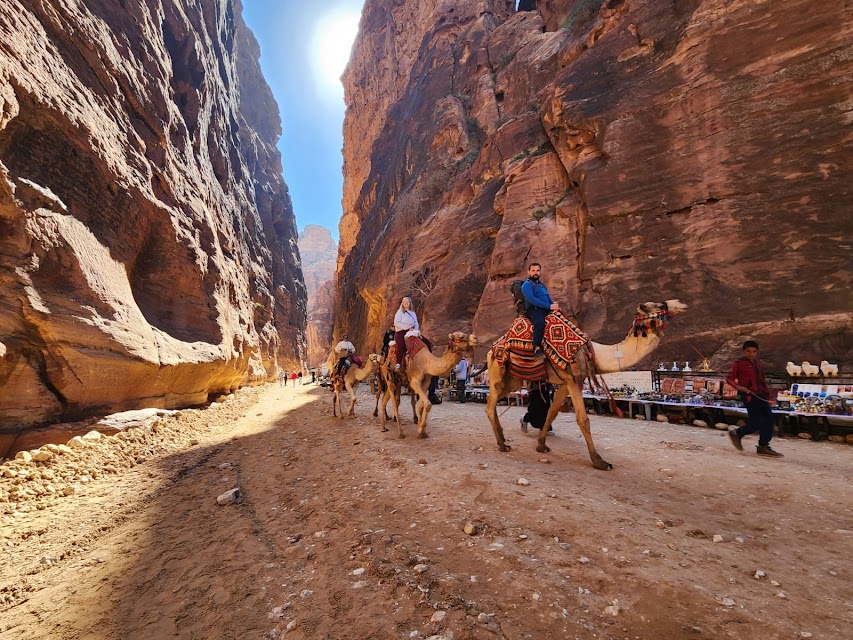A fascinating country with a rich history, a diverse population, and breath-taking natural scenery, Jordan is situated in the Middle East. Explore historic cities, unwind by the Dead Sea, and take in the breath-taking Wadi Rum rock formations while on vacation in Jordan.
Petra, a UNESCO World Heritage Site and one of the New Seven Wonders of the World, is one of Jordan’s top tourist destinations. This ancient city, one of the most magnificent archaeological sites in the world, was carved into the rock more than 2,000 years ago.
The Dead Sea, the lowest point on Earth and a special natural wonder, is another must-see place in Jordan. The mud is claimed to have medicinal effects, while the water’s high salt content prevents sinking.
Additionally, tourists can explore the Wadi Rum desert, where they can go hiking, camp, and learn about the Bedouin way of life. The desert is well-known for its magnificent rock formations and served as a site for the filming of “Lawrence of Arabia.”
Jordan also has the ancient city of Amman, the Red Sea resort of Aqaba, and the Roman ruins of Jerash. Whether you are interested in history, culture, or adventure, Jordan has plenty to offer all types of travelers. In this article, we will give you our opinion what you should do and see when you visit Jordan.
Visit Petra
Petra, an ancient city in Jordan, is regarded as one of the world’s seven “new wonders.” The Nabataeans constructed a UNESCO World Heritage Site more than 2,000 years ago.
The Treasury, a beautiful structure sculpted into the rock face, is Petra’s greatest draw. The Great Temple, the Monastery, and the Royal Tombs are further attractions open to visitors. The city is full with structures cut into the rock, including tombs, temples, and other structures.
Visitors must traverse the Siq, a cramped canyon, to get to Petra. Visitors’ sense of astonishment and wonder when they first view the Treasury is enhanced by the city’s stunning entrance.
Anyone with an interest in history or architecture should travel to Petra. It is regarded as one of the most spectacular archaeological sites in the entire globe and is an amazing achievement of engineering and architecture. The experience of visiting Petra will transport you back in time and last a lifetime.
If you would like to book a tour of Petra, click here or on either the Viator image below to select from one of our preferred suppliers.
Float in the Dead Sea
Jordan’s Dead Sea is a singular natural beauty and a well-liked tourist destination. It is one of the saltiest bodies of water in the world, which is what makes it so distinctive. This unique sensation is made possible by the water’s high salt content, which enables swimmers to float in the water with ease.
Visitors visiting the Dead Sea can benefit from the healing properties of the mineral-rich mud found on its shores in addition to floating in the water. The mud is frequently utilised in spa treatments since it is considered to offer healing effects for a variety of skin ailments.
When visiting Jordan, floating in the Dead Sea is a once-in-a-lifetime experience that shouldn’t be missed. It is truly amazing to experience the calm surroundings and the feeling of simply floating in the water. The Dead Sea is surrounded by breath-taking scenery, making it the perfect location for rest and renewal.
Visit Wadi Rum
The Wadi Rum desert in southern Jordan is renowned for its breath-taking scenery, red sand dunes, and enormous rock formations. The Bedouin people, who have lived in the area for many years, also call it home.
Visitors to Wadi Rum have the option of exploring the desert by camel or jeep trip, which will take them through the stunning scenery and give them the chance to learn about the Bedouin way of life. Visitors can also go rock climbing for a more daring adventure or ride in a hot air balloon to enjoy a bird’s eye perspective of the desert.
In addition, Wadi Rum is a well-liked setting for movie and television productions, including the classic Lawrence of Arabia. Additionally, guests have the option of spending the night in a traditional Bedouin camp, where they can take in a traditional meal, listen to music, and get a good view of the stars at night.
With its distinctive scenery, extensive history, and welcoming Bedouin hospitality, Wadi Rum is a must-visit location for anybody travelling to Jordan.
Explore Amman
Jordan’s capital, Amman, is a thriving center of culture, history, and modernity. Tourists in Amman may explore all ancient ruins, contemporary cafes, and vibrant marketplaces. The city is home to a variety of historical attractions, such as the Citadel, a hilltop fortification from the Roman Empire that offers breath-taking views over the city, and the Roman Theatre, an amphitheater that has been well-preserved and can accommodate up to 6,000 people.
Amman offers a wide variety of museums, art galleries, and cultural activities for individuals who are interested in contemporary culture, including the yearly Amman International Film Festival and the Amman Jazz Festival. Foodies will also appreciate the city’s varied cuisine, which features modern cafés and restaurants serving both foreign cuisine and classic Jordanian specialties like mansaf and falafel.
Amman is a must-visit location in Jordan and has much to offer visitors of all interests, whether they are interested in history, culture, or food.
Explore Jerash
The northern Jordanian city of Jerash is well-known for its ancient Greco-Roman ruins, which date to the first century BC. One of the ten Roman cities that made up the Decapolis League, the ancient city of Jerash, also called Gerasa, was a significant centre of trade and culture during the Roman Empire.
Tourists can still explore the remarkable ruins of Jerash, such as the Hippodrome, the Oval Plaza, and the magnificent Hadrian’s Arch, today. The historic Roman Theatre, which can accommodate up to 3,000 people and is still utilised for cultural events today, is the city’s principal draw.
Jerash provides visitors with the opportunity to experience traditional Jordanian culture through its markets, cuisine, and local festivals in addition to its historical monuments. The city’s annual Jerash Festival of Culture and Arts, which takes place in July, is a must-attend event for tourists seeking a festive setting to enjoy traditional music, dancing, and cuisine.
Anyone interested in ancient history and culture must pay a visit to Jerash, which offers a special perspective into Jordan’s rich history.
Visit Aqaba
The Red Sea coast in southern Jordan is home to the coastal city of Aqaba. It is a well-liked location for diving, snorkeling, and other water sports because of its beautiful beaches, clean waters, and abundant marine life.
Aqaba is endowed with both natural beauty and a vibrant cultural past. Tourists, as can the Aqaba Fort, a fortification built in the fourteenth century to defend the city from attackers, can visit one of the earliest Islamic settlements in Jordan, Ayla.
Aqaba provides a range of opulent resorts and spas, as well as a buzzing nightlife scene, for those seeking a more tranquil experience. While dining, guests can take in the stunning Red Sea, regional wines, and traditional Jordanian fare.
Aqaba serves as a starting point for trips to other Jordanian sights like Petra, Wadi Rum, and the Dead Sea. For any visitor to Jordan, Aqaba is a must-visit location because of its distinctive blend of natural beauty, cultural legacy, and contemporary conveniences.
If you would like to book a tour of Aqaba, click here or on either the Klook image below to select from one of our preferred suppliers.
Visit the Baptism Site of Jesus Christ
On the eastern bank of the Jordan River, in Jordan, is where Jesus was baptized; this location is sometimes referred to as Bethany Beyond the Jordan. One of the holiest places in Christianity, it is thought to be the location where John the Baptist baptized Jesus Christ.
When the area was excavated in the late 1990s, numerous Byzantine-era churches and baptismal pools were found. The archaeological site is open for visitors to explore and includes chapels, monasteries, and church ruins. The ruins of the baptismal pools, where the rites took place, are also visible.
In addition to its religious significance, the location has breath-taking views of the Jordan Valley and is surrounded by beautiful natural features like lush vegetation and the Jordan River’s flowing waters.
Visitors can take part in guided tours or go to the site’s regular church services. Any visitor to Jordan should pay a visit to the Baptism Site of Jesus Christ because of its historical and religious significance.
If you would like to book a tour to see the Baptism site of Jesus Christ, click here or on either the Get Your Guide image below to select from one of our preferred suppliers.
Learn about Bedouin Culture
The culture of the Bedouin plays a significant role in the Middle Eastern experience, especially in nations like Jordan, Saudi Arabia, and Egypt. The Bedouin people are renowned for their distinctive rituals, traditional attire, and nomadic lifestyle.
By living in a Bedouin camp in Wadi Rum or another desert region, visitors visiting Jordan can fully experience Bedouin culture. Here, they can discover the background and customs of the Bedouin people, as well as their talent for producing exquisite fabrics and handicrafts. Additionally, tourists can sample traditional Bedouin cuisine and discover more about their traditions, including how to make coffee and the value of hospitality.
Visitors can also take part in Bedouin cultural activities like camel rides, desert safaris, and traditional dances. They can also go to cultural events like the yearly Jordan Heritage Revival Festival, which honours the Bedouin way of life and features authentic Bedouin dance, music, and crafts.
Any traveler to the Middle East will find learning about Bedouin culture to be a fascinating and educational experience because it offers a distinctive perspective on the region’s history and traditions.
Taste Jordanian Cuisine
The country’s position at the intersection of historic trade routes has affected the exquisite and varied blend of flavors and textures that make up Jordanian cuisine. Grilled meats, veggies, and spices are a large part of the menu. Mansaf, a classic Bedouin dish cooked with lamb, rice, and a tart fermented yoghurt sauce called jameed, is one of the most well-liked foods. Another common dish is falafel, which is made with ground chickpeas and seasonings and is typically eaten with hummus, tahini, and pickled vegetables.
Other well-liked foods include mujadara, a hearty lentil and rice dish flavored with caramelized onions, and shawarma, a sort of gyro cooked with chicken or lamb. Jordan is renowned for its desserts as well, including the rich baklava created with layers of filo dough and honey and the knafeh, a cheese pastry drenched in syrup and topped with pistachios.
Visitors to Jordan can experience the country’s diverse culinary scene by trying local cuisine, dining at neighborhood restaurants, or enrolling in a cooking class to learn how to prepare regional specialties. Any food lover will be delighted by the unique fusion of Middle Eastern and Mediterranean flavors found in Jordanian cuisine.
If you would like to book a tour to taste Jordanian Cuisine, click here or on either the Klook image below to select from one of our preferred suppliers.
Jordanian Festivals
Jordan is renowned for its rich cultural legacy and varied celebrations that provide visitors a fascinating look at its traditions and practices. The Jerash Festival, which takes place in the historic city of Jerash, is one of the most well-known events. The magnificent Roman remains serve as the backdrop for this big cultural celebration, which includes performances by national and international performers. Visitors can take in musical and dance performances, theatre productions, exhibitions, and other forms of entertainment while experiencing Jordan’s rich cultural heritage.
The Amman Summer Festival is another well-known celebration that turns the capital city of Amman into a center for cultural events. This festival presents a wide range of cultural activities, such as musical performances, dance performances, theatrical productions, and visual arts displays. Locals and visitors converge on the streets to observe and take part in the celebrations, bringing the streets to life with a contagious enthusiasm.
For movie lovers, the Jordanian Dead Sea Panorama Film Festival is a major occasion. This festival, which is held close to the famous Dead Sea, offers a venue for regional and international filmmakers to display their work and engage in cross-cultural dialogue.
Jordan also observes religious holidays throughout the year, such as Eid al-Fitr and Eid al-Adha, which commemorate the end of Ramadan and the yearly Hajj journey, respectively. Family get-togethers, feasting, and charitable deeds during these festivals highlight the nation’s strong Islamic heritage and traditions.
Jordanian festivals encourage a sense of pride and unity among its people in addition to offering entertainment and enjoyment. They present a chance for residents and guests to take part in the dynamic spirit of Jordan and explore the rich cultural fabric of the nation.
In conclusion, Jordan is a stunning nation that is abound in natural beauty, history, and culture. There is something for everyone in Jordan, whether you wish to travel across the desert, visit historic ruins, or simply unwind on the beach.




